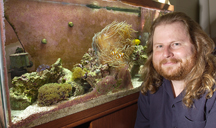
| RELATED INFO |
| * Purdue Department of Biochemistry |
| * The Esther A. & Joseph Klingenstein Fund, Inc |
| * The Alfred P. Sloan Foundation Sloan Research Fellowships |

October 11, 2007
Study of nervous system development garners prestigious fellowships
WEST LAFAYETTE, Ind. - |
Jim Clemens, a biochemistry assistant professor, studies how communication between brain nerve cells, called neurons, leads to the development of the nervous system. His groundbreaking research has earned him two prestigious fellowships.
Clemens wants to define the molecular mechanisms that lead to brain and nervous system damage due to neuron malfunction. His research is based on his discovery of a protein complex and characterization of one of the proteins. The protein facilitates specific neuron connections that allow transmission of molecular orders throughout the body.
In research on fruit flies, Clemens has shown that a specific gene is required to produce the cell surface protein molecules that direct neurons to pair with their correct mate.
The gene in fruit flies, or Drosophila, is named Dscam and is the fly equivalent of a human gene called the Down syndrome cell adhesion molecule (DSCAM). These genes make more than 38,000 protein variations, each of which enable a neuron to interact specifically with another neuron.
"Neurons have to differentiate themselves so that they can recognize their partner or target," Clemens said. The Dscam proteins on the neuron cell surface perform this role.
"Each Dscam protein has a different way of binding, a unique specificity. It's like a toolbox with many different fasteners."
The researchers know that connections among neurons are necessary to send orders down the body's transmission lines, called axons. However, they don't understand the biochemical mechanisms that trigger the correct connections so that a functioning nervous system forms during development.
Starting with the protein receptor Dscam, Clemens now is seeking mechanisms that work with Dscam to ensure specific, reliable connections between neurons. He is investigating some enzymes that may be involved in these processes.
The information that he and his research team garners may allow them to change the connections and reroute axons in order to modify behavior, such as the substances to which insects are attracted. In people, being able to change these connections could offer treatments for some diseases that begin during fetal and childhood development, such as mental retardation, dyslexia, autism, cerebral palsy and pediatric epilepsy.
Although the gene and protein with which Clemens works are named for Down syndrome, it's not known exactly what role they play in that disease. The DSCAM gene is found in the Down syndrome chromosomal region and is overexpressed in Down syndrome patients.
The Alfred P. Sloan Foundation and the Esther A. & Joseph Klingenstein Fund Inc. awarded fellowships totaling almost $200,000 based on his neuroscience research.
Both the Sloan and the Klingenstein fellowships are awarded to researchers in the early stages of their careers. Launched in 1981, the Klingenstein fellowship is $150,000 over three years and is specifically for basic or clinical research aimed at understanding epilepsy. Begun in 1955, the Sloan Fellowship is $45,000 for two years.
Clemens earned his bachelor's and master's degrees at Purdue and his doctorate in biochemistry at the University of Michigan. He then did postdoctoral research focusing on Drosophila genetics at UCLA. He joined Purdue's Department of Biochemistry faculty in 2005.
Writer: Susan A. Steeves, (765) 496-7481, ssteeves@purdue.edu
Source: James Clemens, (765) 494 -1087, jclemens@purdue.edu
Ag Communications: (765) 494-2722;
Beth Forbes, forbes@purdue.edu
Agriculture News Page
PHOTO CAPTION:
Like most laboratories on the Purdue campus, Jim Clemens' lab is crowded with microscopes, computers and graduate students. But it also contains a large saltwater aquarium. Clemens, an assistant professor of biochemistry, says the aquarium is used to inspire and conspire with other researchers. "They come in and look at the fish and we start to talk," Clemens says. "The next thing you know, we're discussing new research possibilities." (Purdue Agricultural Communication photo/Tom Campbell)
A publication-quality photo is available at https://www.purdue.edu/uns/images/+2007/clemens-aquarium.jpg
To the News Service home page
If you have trouble accessing this page because of a disability, please contact Purdue News Service at purduenews@purdue.edu.
